What are Common Dog Behaviors?- dog-behaviors-explained
Dogs, our loyal companions, have a unique way of expressing themselves.
They use body language, vocalizations, and actions to communicate their feelings and needs.
As a dedicated dog owner, deciphering these behaviors can strengthen your bond with your furry friend.
This article will delve into 27 common dog behaviors and help you understand what your dog might be trying to convey.
1. Tail Wagging

A wagging tail doesn’t always mean happiness. The speed and position of the wag can communicate excitement, curiosity, or even caution. Please observe your dog’s overall body language to interpret their mood accurately
Reason: Tail wagging is a versatile communication tool that conveys emotions and intentions.
2. Barking
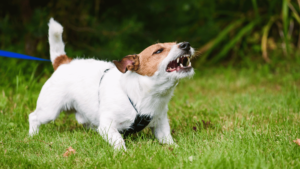
Barking serves various purposes, from alerting you to potential dangers to expressing boredom or anxiety. The barking’s tone, duration, and context offer clues about what’s on your dog’s mind.
Reason: Dogs bark to communicate a wide range of emotions, from alerting you to strangers to expressing their need for attention.
3. Whining

Whining often signals distress, discomfort, or the desire for attention. Check for physical discomfort or other environmental factors if your dog whines excessively.
Reason: Whining is a vocalization that dogs use to express their emotional state, whether it’s discomfort, anxiety, or a desire for companionship.
4. Panting

Dogs pant to regulate their body temperature, but excessive panting might indicate stress, pain, or illness. Monitor the situation and provide your dog with a cool and comfortable environment when needed.
Reason: Dogs pant to regulate their body temperature, but it can also be a sign of stress, pain, or excitement, depending on the context.
5. Jumping
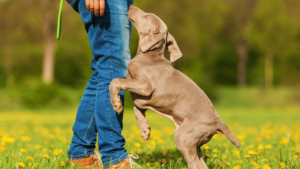
Jumping is usually an expression of excitement or a way for your dog to greet you. Teaching an alternative greeting behavior can help curb this behavior if it becomes overwhelming.
Reason: Jumping is often a result of a dog’s exuberance and eagerness to interact with you, but it’s essential to train them to greet people in a more controlled manner.
6. Rolling Over

When a dog rolls over, they might ask for belly rubs or show submission. However, ensuring that your dog is comfortable and receptive to belly rubs is crucial, as not all dogs enjoy them.
Reason: Rolling over can be a sign of submission or trust, and dogs often expose their bellies to individuals they feel safe and comfortable with.
7. Licking

Licking can signify affection, submission, or simply an attempt to get your attention. If licking becomes obsessive or targeted towards a specific area, consult your vet to rule out underlying health issues.
Reason: Licking is a natural behavior that stems from a dog’s early days of receiving care from their mother. It can signify various emotions, from bonding to showing deference.
8. Chewing

Chewing is natural for dogs and helps with teething dental hygiene, and boredom. Provide appropriate chew toys to redirect this behavior away from your belongings.
Reason: Chewing is essential for a dog’s oral health and serves as an outlet for their natural urge to gnaw and explore their environment.
9. Digging
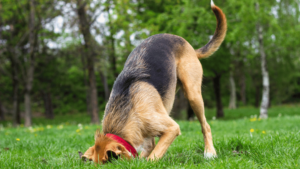
Digging is an instinctive behavior that dates back to a dog’s wild ancestors. It can indicate a need for entertainment, comfort, or a desire to hide something.
Reason: Digging has historical roots in a dog’s ancestral behaviors, serving purposes such as creating a den, finding food, or cooling down in hot weather.
10. Head Tilt
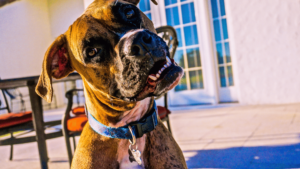
The adorable head tilt often signifies curiosity and attentiveness. Dogs might do this when trying to understand a new sound or word.
Reason: The head tilt helps dogs adjust their ear position to better locate the source of a sound, showing their curiosity and interest in understanding their environment.
11. Scratching
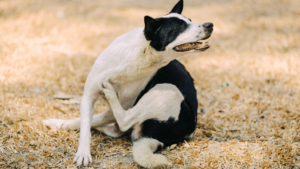
Frequent scratching could be because of allergies, fleas, or skin irritations. Address any potential underlying issues with proper veterinary care.
Reason: Scratching can result from various factors, including external parasites, allergies, skin infections, or discomfort. It’s a dog’s way of seeking relief from an underlying issue.
12. Tail Between Legs

A tucked tail usually suggests fear or submission. Comfort and reassurance can help your dog feel safe in these situations.
Reason: A lowered or tucked tail is a visible indication of a dog’s emotional state, often expressing fear, anxiety, or submission in response to a perceived threat or uncomfortable situation.
13. Raised Hackles

When a dog’s fur stands on end, it shows heightened arousal. It could be because of excitement, aggression, or feeling threatened.
Reason: Raised hackles are an involuntary response triggered by a surge of adrenaline, signaling that a dog is prepared for a fight-or-flight response.
14. Play Bow

The play bow is an invitation to play and is often accompanied by a wagging tail. It’s a common behavior among dogs during social interactions.
Reason: The play bow is a universally recognized signal in the dog world, communicating an intention to engage in friendly play and indicating that the behavior that follows is non-threatening.
15. Nosing

Dogs use their noses to explore the world around them. If your dog is nudging you, they might seek attention or interaction.
Reason: A dog’s sense of smell is highly developed, and their use of their nose is integral to exploring their environment, identifying scents, and interacting with other beings.
16. Zoomies
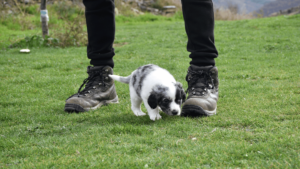
Zoomies are sudden bursts of energy where a dog races around in circles or zigzags. This behavior is typically seen in young dogs and is a way to release pent-up energy.
Reason: Zoomies are an outlet for excess energy and exuberance, especially in young dogs, and can be a fun way for them to let loose and enjoy themselves.
17. Cowering

Cowering shows extreme fear or submission. Identify and address the source of your dog’s fear, helping your dog feel more secure.
Reason: Cowering is a defensive response in which a dog tries to minimize their exposure to perceived threats or frightening situations, indicating a need for safety and comfort.
18. Pawing
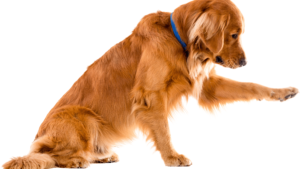
Pawing at you or other objects can be a sign of affection or an attempt to grab your attention. Provide positive reinforcement to encourage desirable behavior.
Reason: Pawing is a natural behavior that dogs use to interact with their environment and communicate with humans, seeking attention, play, or assistance.
19. Mouthing

Puppies often use their mouths to explore the world, but it’s important to teach bite inhibition to prevent this behavior from becoming problematic.
Reason: Mouthing is a developmental stage in puppies when they explore the world using their mouths. Teaching bite inhibition helps them learn how to control their bite strength and interact gently.
20. Sniffing

A dog’s sense of smell is powerful, and sniffing is their way of gathering information about their surroundings and other animals.
Reason: Sniffing is a primary method of gathering information for dogs, allowing them to learn about their environment, identify scents, and even detect changes in emotions and health in other animals.
21. Staring

Staring can indicate curiosity or a desire for your attention. However, prolonged staring can be seen as a challenge by other dogs.
Reason: Staring can be a way for dogs to express curiosity, attentiveness, or a request for interaction. However, in certain contexts, prolonged or intense staring can be interpreted as a threat or challenge by other dogs.
22. Sleeping Positions

Different sleeping positions convey various levels of comfort and vulnerability. Please consider your dog’s sleeping habits to understand their overall well-being.
Reason: Sleeping positions can reveal a dog’s comfort level, relaxation, and confidence, providing insights into their physical and emotional state.
23. Begging

Begging behaviors, such as giving you puppy eyes, stem from a desire for food. While it’s tempting to give in, it’s essential to maintain a consistent feeding routine to avoid overfeeding.
Reason: Begging is a learned behavior that dogs use to request food from humans. While it might seem endearing, it’s important to establish clear boundaries to avoid overfeeding and maintain a healthy diet.
24. Snarling or Growling

These vocalizations signal discomfort, fear, or aggression. Do not punish your dog for growling, as it’s their way of expressing their emotions. Instead, identify and address the underlying cause.
Reason: Snarling and growling are warning signs that a dog is feeling threatened, uncomfortable, or stressed. Punishing these behaviors can suppress warnings and escalate the situation.
25. Limping
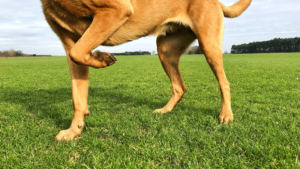
Limping indicates pain or injury. Inspect your dog’s paws and limbs carefully, and consult your vet if the limp persists.
Reason: Limping is a clear indicator of physical discomfort or injury. It’s essential to promptly identify the source of pain and seek appropriate veterinary care.
26. Submissive Urination

Submissive urination is a sign of extreme submission or anxiety. Avoid scolding your dog for this behavior, as it can exacerbate their anxiety.
Reason: Submissive urination is a response to perceived social pressure, and it often occurs when a dog feels overwhelmed, anxious, or submissive in certain situations. Scolding can exacerbate these emotions.
27. Howling

Howling is a form of communication that can express loneliness, respond to sirens, or even call out to other dogs in the area.
Reason: Howling is a natural vocalization that has evolved as a way for dogs to communicate across long distances. Dogs might howl to express their emotions, alert others, or even join in with other howling dogs.
Final Thought
Understanding your dog’s behaviors is like unlocking a secret language that strengthens your bond with your furry companion. You’ll be better equipped to meet their needs and ensure their well-being by paying attention to their body language, vocalizations, and actions.
Remember, every dog is unique, so take the time to observe and learn your dog’s quirks and behaviors. This journey of understanding will enrich your relationship and create a happier, healthier life for you and your beloved canine friend.
